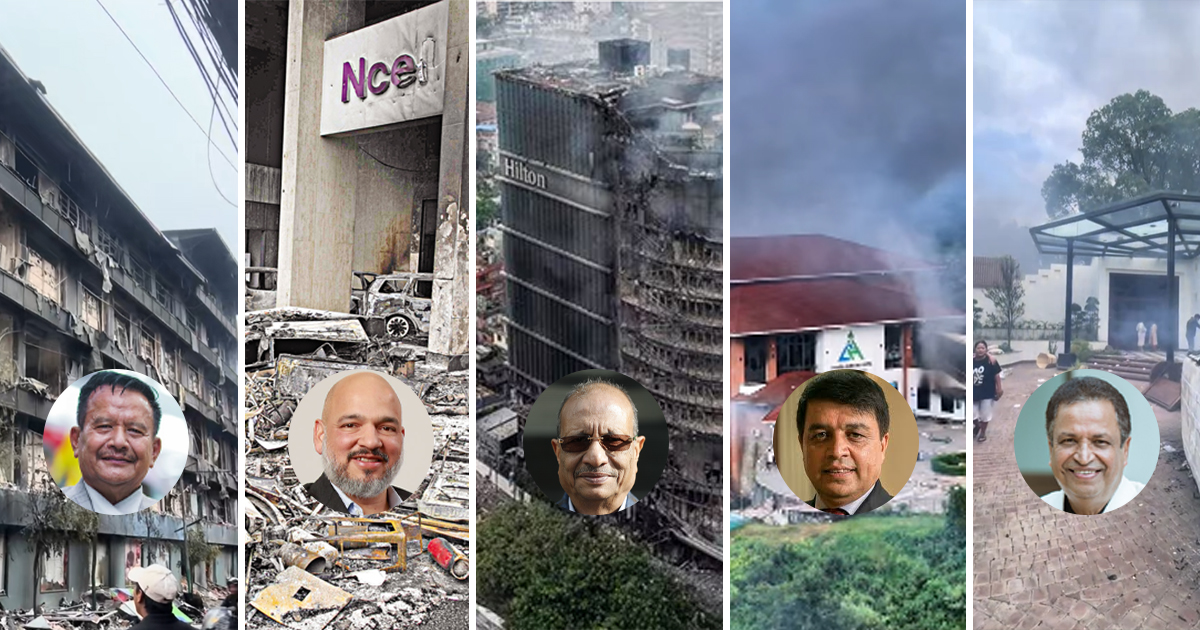Kathmandu: The nationwide uprising led by Nepal’s Gen Z youth (aged 13–28) on September 8 against corruption and misgovernance triggered one of the darkest chapters in the country’s modern history.
After state forces responded with brutal suppression, killing at least 19 protesters, rage erupted the following day. By the morning of September 9, furious crowds had unleashed waves of arson and vandalism across the nation.
No institution of power was spared. The administrative centre at Singha Durbar, the Parliament building, the Office of the President, the Supreme Court, the Commission for the Investigation of Abuse of Authority, the Prime Minister’s official and private residences, former prime ministers’ homes, ministers’ residences, hundreds of police stations, and most government offices and political party headquarters across the country were reduced to ashes. Thousands of private properties also fell victim to destruction.
The fury soon turned toward the private sector. Business leaders—long symbols of wealth and influence—were targeted one by one. Billionaire Binod Chaudhary, Nepal’s only dollar billionaire, saw his private home and corporate offices looted and torched. More than half a dozen vehicles were burned to ashes.
Min Bahadur Gurung’s Bhatbhateni supermarket chain suffered perhaps the most extensive destruction: 12 outlets nationwide were looted and set on fire, while another half-dozen were heavily ransacked.
Tourist landmark Chandragiri Hills, built under industrialist Chandra Dhakal but largely funded by ordinary investors, was vandalized and torched. Dhakal’s Maulakali Cable Car base station was also destroyed.
The Shanker Group’s five-star Hilton Hotel in Naxal, built with billions in investment, was looted and then burned. Ncell’s headquarters in Lazimpat, a vital telecom provider, was set ablaze, raising concerns over essential infrastructure.
Shekhar Golchha’s residence was vandalized and four of his vehicles torched. Sanjay Golchha’s house was completely destroyed in a fire. Basanta Chaudhary’s residence in Thamel was attacked, while Non-Resident Nepali Association founder Upendra Mahato’s house was looted, vandalized, and set ablaze.
Thapathali-based automobile showrooms—Tata, Hyundai, Mahindra, and CG Motors—were burned to the ground. Central Park, which houses the Kantipur Publications office, was destroyed in fire. Rajesh Agrawal’s RMC Group office inside the building was also damaged. Half a dozen bank branches and ATMs were looted and vandalized.
Rameshwar Thapa’s Simrik Air, the Annapurna Post office, and his residence in Kavre were torched. Businessman Pawan Golyan’s Golyan Tower office, Rajendra Bajgain’s Babarmahal hotel, and the Marwari Sewa Samiti Tower in Battisputali were attacked.
Even educational institutions were not spared. Global College of Management in Old Baneshwor was vandalized. Pokhara’s Bagaincha Resort and investor Bindukumar Thapa’s residence also came under attack.
Across the nation, businesses and private residences were ravaged. The same entrepreneurs who had created jobs, paid billions in taxes, and contributed to Nepal’s economy now saw their contributions erased in hours of fire and fury.
Across the nation, businesses and private residences were ravaged. The same entrepreneurs who had created jobs, paid billions in taxes, and contributed to Nepal’s economy now saw their contributions erased in hours of fire and fury.
Governor Bishwanath Poudel’s homes in Bhaisepati and Chitwan were torched. The residences of the chief of the anti-corruption commission, Prem Rai, and the prime minister’s economic adviser, Yubaraj Khatiwada, were vandalized. From villages to cities, public and private properties were set on fire, and thousands of vehicles were destroyed.
The financial toll is staggering. Billions worth of property went up in flames within hours. The scale of reconstruction is so immense that analysts warn Nepal’s fragile economy cannot possibly absorb the shock. Economists fear the destruction has set the country back by decades—“perhaps 50 years,” some argue.
The material loss is only part of the story. The morale of the country’s industrialists and entrepreneurs has been shattered. Restoring their confidence, observers warn, will be an uphill battle. Without it, Nepal risks capital flight, dwindling investments, and further erosion of job creation.
If the new leadership fails to rebuild confidence among both the people and national capitalists, they could soon meet the same political fate as former prime ministers KP Sharma Oli and Sher Bahadur Deuba—leaders once powerful, later discarded.
Destroying private property to advance political demands, regardless of who is behind it, needs to be condemned as “shameful and self-defeating.” The violence terrorized society in ways even the old parties never dared. From a terrified society, neither good governance nor prosperity can emerge.
Gen Z may be destined to lead Nepal, but now they face a paradox: they have destroyed the very institutions—offices, courts, and workplaces—necessary to run a government. “Where will a Gen Z–led government sit to deliver services to the people?” the text asks.
Entrepreneurs employ hundreds of thousands and pay billions in taxes—both lifelines of state functioning. Without jobs and taxes, governance collapses. Ironically, it is youth frustration over unemployment and stagnant incomes that fueled the protests in the first place.
While Nepal’s older political class had failed to bring prosperity, the Gen Z movement too appears to have spiralled out of its own control. Opportunistic groups, including those allegedly linked to controversial figure Durga Prasai, are suspected of exploiting the chaos for their own gains.
The new government will face urgent pressure to identify and prosecute those responsible for instigating and escalating the violence. Only then, analysts say, can social terror be eased and public trust gradually restored.
But trust is now in short supply. Without it, investors will not commit new capital; instead, they will quietly move their money abroad. With no fresh investment, job creation stalls, unemployment rises, and more young Nepalis flee overseas. Food insecurity looms, and desperation could fuel even more looting and unrest, perpetuating a vicious cycle of anger and destruction.
But trust is now in short supply. Without it, investors will not commit new capital; instead, they will quietly move their money abroad. With no fresh investment, job creation stalls, unemployment rises, and more young Nepalis flee overseas.
Nepal today stands at a crossroads. The Gen Z protests demonstrated the immense power of a restless youth population: within 24 hours, a government that seemed untouchable collapsed. But the movement also exposed the dangers of rage without vision.
Internal disputes among Gen Z leaders over government formation on September 10–11 already signal tough days ahead. Anger alone cannot build a nation. To chart a path forward, Nepal needs visionary, patient, and universally acceptable leadership—qualities the Gen Z leadership has yet to display.
The hot blood of youth alone cannot build a country. What is needed is wisdom, restraint, and a clear vision.



Comment Here